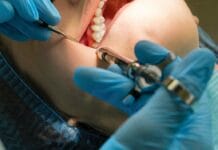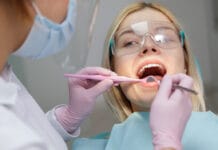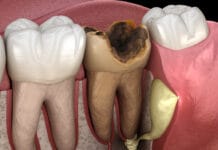Disclosure: This quiz is sponsored content from Verena Solutions as part of our sponsored partner program.
Test your injection safety and sharps injury knowledge and then enter to win a huge prize pack from Verena Solutions, including a bag of their SimpleCAP dental safety needles, an aspirating syringe, N95 mask, an earloop relief, face shield, t-shirt, and cloth mask!
The SimpleCAP dental safety needle is a self-contained dental needle that provides both safety and ease of use to help reduce the risk of needlestick injuries. Easily threaded on any dental aspirating syringe, SimpleCAP contains the needle at all times, providing protection to the user from the start of the procedure to clean up.

Now let's test your injection safety and sharps injury knowledge!
Annually, how many infections are estimated to be transmitted through sharps/needle stick injuries?
The 1st standard put forth by OSHA was in 1991. By implementing this standard, it was estimated that it would prevent between 5,058-5,781 occupational HBV infections and between 113-129 HBV deaths.1
Although this standard was very successful, there is still an average of 1,000 infections caused by 20 pathogens transmitted through needlestick injuries every year in dental settings.2
1. United States Department of Labor. Occupational Safety and Health Administration. Statement of Charles N. Jeffress, Assistant Secretary, Before the Subcommittee on Workforce Protections. Retrieved from https://www.osha.gov/news/testimonies/06222000
2. Gupta, N., Tak, J. Needlesticks Injuries in Dentistry. Kathmandu Univ Med J (KUMJ). 2011 Jul-Sep; 9(35): 208-12. PMID: 22609509. Retrieved from https://pdfs.semanticscholar.org/4559/ea690cf3369bd0b32124e9b0d196a6c610db.pdf
The greatest threats to dental professionals that experience a needlestick injury are Hep B, Hep C, and HIV. However, additional infectious diseases such as syphilis, Prions, Influenza, Diphtheria, and Mononucleosis can be acquired through needlestick injuries as well.
HIV, HBV, and HCV are often the infectious diseases most often mentioned when discussing infection control and needlestick injuries. Though they are certainly the infectious diseases that pose the highest risk to dental professionals, there is a laundry list of others that should not be dismissed. Other infectious diseases that can be acquired through needlestick injuries, albeit rare, include syphilis, Blastomycosis, Brucellosis, Cryptococcosis, Diphtheria, Malaria, T.B., Prions, Ebola, Herpes, Mumps, Rubella, Rubeola, Infectious Mononucleosis, Influenza, Swine flu.1
1. Gupta, N., Tak, J. Needlesticks Injuries in Dentistry. Kathmandu Univ Med J (KUMJ). 2011 Jul-Sep; 9(35): 208-12. PMID: 22609509. Retrieved from https://pdfs.semanticscholar.org/4559/ea690cf3369bd0b32124e9b0d196a6c610db.pdf
In the U.S., there are an estimated 600,000 needlesticks annually, half of which go unreported.
In the U.K., an average of 40,000 sharp injuries are recorded; the actual number of injuries each year is hard to pinpoint as the majority go unreported. In the U.S., there are an estimated 600,000 needlestick injuries annually, half of which go unreported. There is no way to know the exact number of unreported needlestick injuries, though even one unreported incident is too many.1,2
1. Imran, A., Imran, H., Ashley, M.P. Straight to the Point: Considering Sharp Safety in Dentistry. Br Dent J. 2018 Sep 14; 225(5): 391-394. doi: 10.1038/sj.bdj.2018.743. Epub 2018 Aug 24. PMID: 30140045. Retrieved from
2. King, K.C., Strony, R. Needlestick. [Updated 2020 Aug 10]. In: StatPearls [Internet]. Treasure Island (F.L.): StatPearls Publishing; 2020 Jan-. Retrieved from https://www.ncbi.nlm.nih.gov/books/NBK493147/The cost to treat an occupational infection, such as HIV, due to a needle stick injury, can range from $35,000 to $440,000 over a lifetime. The use of safety-engineered devices, along with training, has been shown to reduce the incidence of needlestick injuries substantially.
The estimated annual cost of treating infectious diseases vary. In a systematic review, it was reported that the “annual treatment costs and lifetime medical costs for HBV ($3,600 and $31,306, respectively), HCV ($24,424 and $23,173, respectively), and HIV infection ($35,745 and $441,342, respectively).”1
In a meta-analysis published in 2015, the authors state, “there is strong evidence needlestick injuries can be prevented.” They go on to show the use of safety-engineered devices, such as SimpleCAP (Verena Solutions) can reduce needlestick injuries by 49%.2 Reduced incidence of needlestick injuries will reduce infectious disease transmission and economic burden. This is a simple solution that will keep dental professionals safe as well as save money in the end. Please be diligent in reporting needlestick injuries; it is always a good idea to consider post-exposure prophylaxis.
1. Mannocci, A., De Carli, G., Di Bari, V., et al. How Much do Needlestick Injuries Cost? A Systematic Review of the Economic Evaluations of Needlestick and Sharps Injuries Among Healthcare Personnel. Infect Control Hosp Epidemiol. 2016; 37(6): 635-646. doi:10.1017/ice.2016.48. Retrieved from https://www.ncbi.nlm.nih.gov/pmc/articles/PMC4890345/
2. Tarigan, L.H., Cifuentes, M., Quinn, M., Kriebel, D. Prevention of Needlestick Injuries in Healthcare Facilities: A Meta-analysis. Infect Control Hosp Epidemiol. 2015 Jul; 36(7): 823-9. doi: 10.1017/ice.2015.50. Epub 2015 Mar 13. PMID: 25765502. Retrieved from https://pubmed.ncbi.nlm.nih.gov/25765502/
Which of the following is included in the steps for needlestick injuries?
“If you experienced a needlestick or sharps injury or were exposed to the blood or other body fluid of a patient during the course of your work, immediately follow these steps:
- Wash needlesticks and cuts with soap and water
- Flush splashes to the nose, mouth, or skin with water
- Irrigate eyes with clean water, saline, or sterile irrigants
- Report the incident to your supervisor
- Immediately seek medical treatment”1
1. Centers for Disease Control and Prevention. The National Institute for Occupational Safety and Health (NIOSH). Bloodborne Infectious Diseases: HIV/AIDS, Hepatitis B, Hepatitis C. Emergency Sharps Information. Retrieved from https://www.cdc.gov/niosh/topics/bbp/emergnedl.html
The standards in the Needlestick Safety and Prevention Act in regard to the use of safer medical devices, includes self-sheathing needle and sharps with engineered sharps injury protections and needleless systems.
The standard states, “engineering and work practice controls shall be used to eliminate or minimize employee exposure.” The 2001 revision defines engineering controls as “controls (e.g., sharps disposal containers, self-sheathing needles, safer medical devices, such as sharps with engineered sharps injury protections and needleless systems) that isolate or remove the bloodborne pathogens hazard from the workplace.”1
1. United States Department of Labor. Occupational Safety and Health Administration. Quick Reference Guide to the Bloodborne Pathogens Standard. Retrieved from https://www.osha.gov/bloodborne-pathogens/quick-reference
Post exposure prophylaxis is not available for which bloodborne pathogen?
In a study evaluating 2,947 sharps injuries and confirmed infection with bloodborne pathogens between 2002 and 2011, fourteen health care workers acquired hepatitis C while there were no reports of infection with HIV and hepatitis B. This is attributed to the fact that there is currently no post-exposure prophylactic treatment for hepatitis C. The study was conducted in the U.K.; the study goes on to cite the Needlestick Safety and Prevention Act implemented in the U.S. and states there has been a reduction in sharps injuries since it was implemented. This reduction can be attributed to the requirement of safety-engineered devices in conjunction with training and adherence to standard infection control procedures.1
1. Rice, B.D., Tomkins, S.E., Ncube, F.M. Sharp truth: Health Care Workers Remain at Risk of Bloodborne Infection. Occup Med (Lond). 2015 Apr; 65(3): 210-4. doi: 10.1093/occmed/kqu206. Epub 2015 Feb 6. PMID: 25663385. Retrieved from https://pubmed.ncbi.nlm.nih.gov/25663385/












